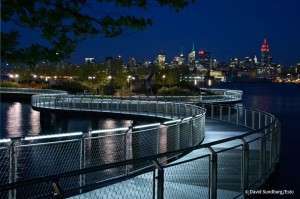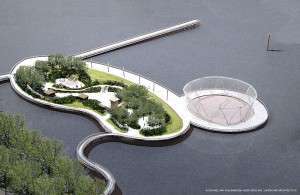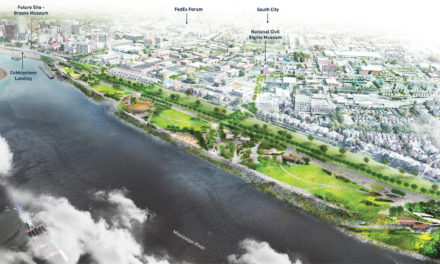We wrote yesterday about what Tom Lee Park could be…a magnet for recreation and leisure…as opposed to what it is today…forlorn and bleak. We got an email asking for some ideas of what could be done, and we suggest that anyone interested in possibilities should visit the website of Michael Van Valkenburgh Associates Inc, landscape architecture firm that creates environmentally sustainable and experientially rich places across a wide range of landscape scales.
Our favorite project is along the Hudson River in Hoboken, New Jersey. That said, you can click any of his waterfront projects on this page if you want to see what can be done when an open space on the water is a real park instead of a festival grounds.
Here’s how the firm describes the Hoboken project and it’s enough to give a hint of what can happen when we attract the best and brightest nationally to work with our local best and brightest to get Tom Lee Park fixed:
Pier C Park is located along the Hudson River Waterfront Walkway in Hoboken, New Jersey and is part of the city’s ongoing efforts to provide recreational open space at the water’s edge. An active recreation pier designed to accommodate users of all ages, the new park complements neighboring parks in program and form. Pier C represents a new generation of waterfront programming, defined by recreation and public access rather than industrial or maritime uses. The new pier sits within the rectilinear footprint of the long-absent original Pier C, with arcing walkways that capitalize on views to Manhattan as well as the active uses of the pier.

The sculptural quality of the landscape simulates the forms of a barrier beach while the interior breaks open to reveal the play landscape—a whimsical, other-scaled world designed to engage children of all ages and abilities. The playground is separated into a pre-school play area and a school-age play area including structures for climbing and hiding, slides, sand play, water play, climbable slopes, rockers and spinners. A continuous tricycle path loops through the interior of the play area and a park building is situated such that an employee can easily dispense toys to children.
The Promenade, at the eastern edge of the pier, provides recreational opportunities for adults and families. In addition to the introduction of lawn areas for sunbathing and casual games, there is ample seating located along the water’s edge. The park encourages users to experience waterfront wildlife opportunities, including the use of a planting scheme that strongly favors coastal species and the construction of a roosting structure for nesting osprey.





So you want a “Real Park”…what does this constitute? Everything I see in the pictures would reduce the open areas and prevent large crowds or bbq booths. Does this involve taking up more of the park with useless projects and immoveable structures?
The Beale Street Music Festival is just starting to gain a lot of national attention, you change the park too much and this event will not be able to function in the space that is left.
Memphis in May World Championship BBQ Cooking Contest (WCBCC) will also suffer from a smaller, changed Tom Lee. The WCBCC is the oldest of the “BIG 4” bbq contests in the world. The other three are the Kansas City Royal, The Jack Daniels, and the Texas Rodeo. Teams come from all over the world to cook next to the Mighty Mississippi. You take that away, and you will lose a lot of revenue, as well as publicity for the city. It was moved last year due to the flooding, but many companies and teams threatened to not return if it didn’t move back to the river. Changing the park’s landscape, will force a move, and a loss of a beloved tradition.
I just hope that before you leap, you weigh what you are forcing many of us to give up.
The riverfront parks at Chattanooga and Louisville, KY are probably more appropriate comparisons for Tom Lee both in type and scale. I would also throw in Van Valkenburgh’s proposal for the Brooklyn Bridge park for some inspiration also.
City government should aim for Tom Lee Park to achieve its optimal potential as a park, not as a festival ground, and in the best interest of the entire public rather than a tenant who uses the park for a few days a year and somehow gets to determine that we can’t have the great public space that we deserve.
One of the biggest issues faced when design riverfront improvements in Memphis is the incredible variations in water levels that occur throughout the year. The height of water on the river gauge at Memphis has historically varied by as much as 58 feet. On an annual basis that range is closer to 30-35 feet which is still a formidable challenge to take into consideration. This matters b/c while we want to create a unique and “world class” waterfront experience, the location of said water varies wildly. We want to invest in the riverfront, but the nature of that investment is limited to what can and should endure possible submersion and powerful river currents for days, weeks or months at a time.
No other city on the Mississippi River has created a great riverfront experience while also dealing with the variations in water height that are experienced here. Chattanooga, Louisville, Cincinnati, Pittsburgh, Little Rock and many other cities that have or are in the process of rebuilding their riverfronts enjoy lock and dam control of their rivers. Stages still vary greatly, but are limited in the range of their extremes to 20- 30 feet. This also enables them to enjoy a relatively steady and guaranteed “low pool” water level necessary to ensure navigation. While not a dam controlled section, the variations in the river level at New Orleans amounts to no more than 23 feet between record crest and record low. St. Louis, Baton Rouge, Vicksburg, Natchez and a host of other cities and towns (not limited to the Mississippi R.) continue to grapple with the issue of creating great public spaces along riverfronts with wide variations in river levels.
Chicken or egg thought. It was mentioned by a previous poster that there are not enough people to support TLP. I agree. Great places need Identity, Density and Livability. Downtown still fails the density test which in many ways drives the others. Or perhaps the linkage to other neighborhood test.
If we focused on what was within a half mile walk of TLP would the park begin to solve itself?
If we focused on linking the park to a larger system (thanks Urbanut), that begins to help.
But we are over-parked/public-spaced for our population. Therefor what we have is impossible to program and maintain.
If we shoot to change the identity of TLP alone, then does it become a destination that has to accommodate visitors? If so, is that really any better than a much more glorified, expensive and landscaped MIM festival ground?
I do think it should be improved. I do think it multiple programing options including MIM can coexist in a better space. However, I think the real solution may lie on Front and Wagner and Second and Third.
John-
Agree with you comment regarding density and programming.
Suggestion: In keeping with concentrating efforts on density in the core rather than making TLP an auto-oriented destination, TLP should be re-imagined in the vein of NYC’s High Line and Chicago’s Millennium Park. Perhaps Riverside Drive could undergo a narrowing and complete streets renovation in the course of connecting TLP with other pik/ped paths. Instead of a mere asphalt course that has sufficed for “green lines” thus far, design ecologically friendly plantings, native grasses, etc., with permeable and impermeable surfaces. Something that celebrates the ecology of the region, that complements the grand sunsets and informs the richness of the Mississippi Delta.